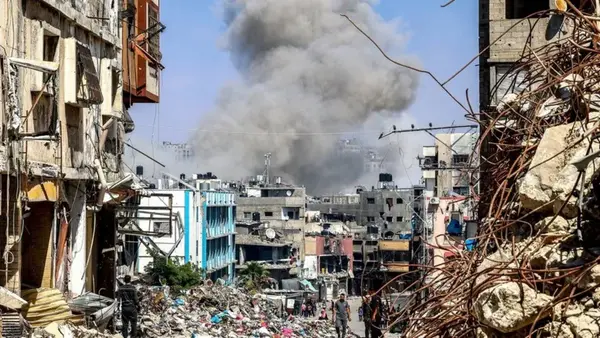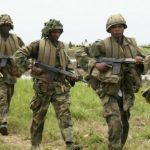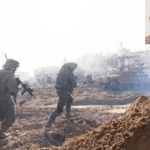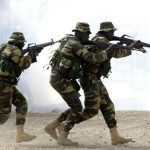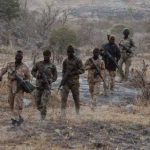Israeli forces and Palestinian groups say there have been intense battles in the northern Gazan town of Jabalia.
Israel’s military said troops had killed “a large number of terrorists” in Jabalia’s refugee camp, while Hamas said it had killed several soldiers.
Tens of thousands of civilians have fled Jabalia since Saturday, when the military said it would re-enter the area because Hamas had regrouped there.
Fierce fighting is also continuing around the southern city of Rafah.
The UN says 450,000 people taking refuge have been displaced since the start of an Israeli ground operation in the city’s eastern outskirts nine days ago.
With tanks now pushing into built-up areas and the two nearby border crossings closed or inaccessible, supplies and medical services are dwindling.
UN Secretary General Antonio Guterres said on Tuesday that he was “appalled” by the escalation in Rafah, warning it was “worsening an already dire situation”.
But Israeli Prime Minister Benjamin Netanyahu on Wednesday pushed back against criticism of its operation, saying: “The humanitarian catastrophe that has been spoken of has not been realized, nor will it.”
Israel launched a military campaign to destroy Hamas in response to the group’s cross-border attack on southern Israel on 7 October, during which about 1,200 people were killed and 252 others were taken hostage.
More than 35,230 people have been killed in Gaza since then, according to the territory’s Hamas-run health ministry.
The Israel Defense Forces (IDF) said in a statement on Wednesday that troops had begun “an operation against terrorist operatives and infrastructure in the centre of Jabalia camp” overnight.
Hamas’s military wing also reported battles inside Jabalia camp on Wednesday and said fighters had targeted Israeli troops with anti-tank missiles and various other explosive devices.
It claimed that a dozen soldiers had been killed in attacks on a bulldozer, a tank and a house in the Block 4 area of the camp. The IDF did not report any casualties.
The Hamas-affiliated Safa news agency reported that air and artillery strikes had caused widespread destruction in areas where the troops had advanced.
Meanwhile, the official Palestinian news agency, Wafa, said four people were killed in an overnight Israeli air strike on a house in Jabalia town.
Wafa also said there had been violent shelling of the Zeitoun neighbourhood, in eastern Gaza City, from which Israeli troops withdrew on Wednesday following a separate six-day operation.
The IDF said the troops had “eliminated dozens of terrorists in encounters and airstrikes, destroyed terrorist infrastructure and located many weapons”.
On Tuesday night, Gaza’s Hamas-run Civil Defence force said it had recovered the bodies of five people, including a woman and her child, in two Israeli air strikes in Sheikh Radwan and another part of Gaza City.
The IDF said aircraft had struck about 80 “terror targets” across Gaza over the past day, including military compounds and weapons storage facilities.
Israel scaled down military operations in the north in January after declaring that it had “dismantled” Hamas’s battalions there. But that left a power vacuum in which the group has been able to rebuild.
An estimated 300,000 people trapped in the devastated region are also experiencing a “full-blown famine” due to a lack of aid deliveries, according to the head of the World Food Programme.
Israel says it needs to send troops into Rafah, in the south, because Hamas’s last remaining battalions are based there along with the group’s leaders and surviving hostages.
The UN and Western powers have warned that an all-out ground assault could lead to mass civilian casualties and a humanitarian catastrophe.
Civilians in Rafah have been told to head north towards areas which the UN says lack essential services
The IDF has ordered the evacuation of a number of neighbourhoods since 6 May, when it began what it called “precise operations in specific areas of eastern Rafah and the Gazan side of the Rafah crossing”.
On Wednesday, a statement said troops had been targeting a Hamas training compound, “eliminating terrorists in close-quarters combat” and locating weapons and “equipment intended to simulate that of the IDF”.
Israeli troops reportedly advanced to within less than 1.6km (1 mile) from the centre of Rafah on Tuesday, when an Israeli soldier was killed in the south.
The IDF has told displaced residents to head towards an “expanded humanitarian area”, which stretches north from the coastal strip of al-Mawasi to the town of Deir al-Balah, in Gaza’s Middle Area.
Israeli forces and Palestinian groups say there have been intense battles in the northern Gazan town of Jabalia.
Israel’s military said troops had killed “a large number of terrorists” in Jabalia’s refugee camp, while Hamas said it had killed several soldiers.
Tens of thousands of civilians have fled Jabalia since Saturday, when the military said it would re-enter the area because Hamas had regrouped there.
Fierce fighting is also continuing around the southern city of Rafah.
The UN says 450,000 people taking refuge have been displaced since the start of an Israeli ground operation in the city’s eastern outskirts nine days ago.
With tanks now pushing into built-up areas and the two nearby border crossings closed or inaccessible, supplies and medical services are dwindling.
UN Secretary General Antonio Guterres said on Tuesday that he was “appalled” by the escalation in Rafah, warning it was “worsening an already dire situation”.
But Israeli Prime Minister Benjamin Netanyahu on Wednesday pushed back against criticism of its operation, saying: “The humanitarian catastrophe that has been spoken of has not been realized, nor will it.”
Israel launched a military campaign to destroy Hamas in response to the group’s cross-border attack on southern Israel on 7 October, during which about 1,200 people were killed and 252 others were taken hostage.
More than 35,230 people have been killed in Gaza since then, according to the territory’s Hamas-run health ministry.
The Israel Defense Forces (IDF) said in a statement on Wednesday that troops had begun “an operation against terrorist operatives and infrastructure in the centre of Jabalia camp” overnight.
Hamas’s military wing also reported battles inside Jabalia camp on Wednesday and said fighters had targeted Israeli troops with anti-tank missiles and various other explosive devices.
It claimed that a dozen soldiers had been killed in attacks on a bulldozer, a tank and a house in the Block 4 area of the camp. The IDF did not report any casualties.
The Hamas-affiliated Safa news agency reported that air and artillery strikes had caused widespread destruction in areas where the troops had advanced.
Meanwhile, the official Palestinian news agency, Wafa, said four people were killed in an overnight Israeli air strike on a house in Jabalia town.
Wafa also said there had been violent shelling of the Zeitoun neighbourhood, in eastern Gaza City, from which Israeli troops withdrew on Wednesday following a separate six-day operation.
The IDF said the troops had “eliminated dozens of terrorists in encounters and airstrikes, destroyed terrorist infrastructure and located many weapons”.
On Tuesday night, Gaza’s Hamas-run Civil Defence force said it had recovered the bodies of five people, including a woman and her child, in two Israeli air strikes in Sheikh Radwan and another part of Gaza City.
The IDF said aircraft had struck about 80 “terror targets” across Gaza over the past day, including military compounds and weapons storage facilities.
Israel scaled down military operations in the north in January after declaring that it had “dismantled” Hamas’s battalions there. But that left a power vacuum in which the group has been able to rebuild.
An estimated 300,000 people trapped in the devastated region are also experiencing a “full-blown famine” due to a lack of aid deliveries, according to the head of the World Food Programme.
Israel says it needs to send troops into Rafah, in the south, because Hamas’s last remaining battalions are based there along with the group’s leaders and surviving hostages.
The UN and Western powers have warned that an all-out ground assault could lead to mass civilian casualties and a humanitarian catastrophe.
Civilians in Rafah have been told to head north towards areas which the UN says lack essential services
The IDF has ordered the evacuation of a number of neighbourhoods since 6 May, when it began what it called “precise operations in specific areas of eastern Rafah and the Gazan side of the Rafah crossing”.
On Wednesday, a statement said troops had been targeting a Hamas training compound, “eliminating terrorists in close-quarters combat” and locating weapons and “equipment intended to simulate that of the IDF”.
Israeli troops reportedly advanced to within less than 1.6km (1 mile) from the centre of Rafah on Tuesday, when an Israeli soldier was killed in the south.
The IDF has told displaced residents to head towards an “expanded humanitarian area”, which stretches north from the coastal strip of al-Mawasi to the town of Deir al-Balah, in Gaza’s Middle Area.
Israeli forces and Palestinian groups say there have been intense battles in the northern Gazan town of Jabalia.
Israel’s military said troops had killed “a large number of terrorists” in Jabalia’s refugee camp, while Hamas said it had killed several soldiers.
Tens of thousands of civilians have fled Jabalia since Saturday, when the military said it would re-enter the area because Hamas had regrouped there.
Fierce fighting is also continuing around the southern city of Rafah.
The UN says 450,000 people taking refuge have been displaced since the start of an Israeli ground operation in the city’s eastern outskirts nine days ago.
With tanks now pushing into built-up areas and the two nearby border crossings closed or inaccessible, supplies and medical services are dwindling.
UN Secretary General Antonio Guterres said on Tuesday that he was “appalled” by the escalation in Rafah, warning it was “worsening an already dire situation”.
But Israeli Prime Minister Benjamin Netanyahu on Wednesday pushed back against criticism of its operation, saying: “The humanitarian catastrophe that has been spoken of has not been realized, nor will it.”
Israel launched a military campaign to destroy Hamas in response to the group’s cross-border attack on southern Israel on 7 October, during which about 1,200 people were killed and 252 others were taken hostage.
More than 35,230 people have been killed in Gaza since then, according to the territory’s Hamas-run health ministry.
The Israel Defense Forces (IDF) said in a statement on Wednesday that troops had begun “an operation against terrorist operatives and infrastructure in the centre of Jabalia camp” overnight.
Hamas’s military wing also reported battles inside Jabalia camp on Wednesday and said fighters had targeted Israeli troops with anti-tank missiles and various other explosive devices.
It claimed that a dozen soldiers had been killed in attacks on a bulldozer, a tank and a house in the Block 4 area of the camp. The IDF did not report any casualties.
The Hamas-affiliated Safa news agency reported that air and artillery strikes had caused widespread destruction in areas where the troops had advanced.
Meanwhile, the official Palestinian news agency, Wafa, said four people were killed in an overnight Israeli air strike on a house in Jabalia town.
Wafa also said there had been violent shelling of the Zeitoun neighbourhood, in eastern Gaza City, from which Israeli troops withdrew on Wednesday following a separate six-day operation.
The IDF said the troops had “eliminated dozens of terrorists in encounters and airstrikes, destroyed terrorist infrastructure and located many weapons”.
On Tuesday night, Gaza’s Hamas-run Civil Defence force said it had recovered the bodies of five people, including a woman and her child, in two Israeli air strikes in Sheikh Radwan and another part of Gaza City.
The IDF said aircraft had struck about 80 “terror targets” across Gaza over the past day, including military compounds and weapons storage facilities.
Israel scaled down military operations in the north in January after declaring that it had “dismantled” Hamas’s battalions there. But that left a power vacuum in which the group has been able to rebuild.
An estimated 300,000 people trapped in the devastated region are also experiencing a “full-blown famine” due to a lack of aid deliveries, according to the head of the World Food Programme.
Israel says it needs to send troops into Rafah, in the south, because Hamas’s last remaining battalions are based there along with the group’s leaders and surviving hostages.
The UN and Western powers have warned that an all-out ground assault could lead to mass civilian casualties and a humanitarian catastrophe.
Civilians in Rafah have been told to head north towards areas which the UN says lack essential services
The IDF has ordered the evacuation of a number of neighbourhoods since 6 May, when it began what it called “precise operations in specific areas of eastern Rafah and the Gazan side of the Rafah crossing”.
On Wednesday, a statement said troops had been targeting a Hamas training compound, “eliminating terrorists in close-quarters combat” and locating weapons and “equipment intended to simulate that of the IDF”.
Israeli troops reportedly advanced to within less than 1.6km (1 mile) from the centre of Rafah on Tuesday, when an Israeli soldier was killed in the south.
The IDF has told displaced residents to head towards an “expanded humanitarian area”, which stretches north from the coastal strip of al-Mawasi to the town of Deir al-Balah, in Gaza’s Middle Area.
Israeli forces and Palestinian groups say there have been intense battles in the northern Gazan town of Jabalia.
Israel’s military said troops had killed “a large number of terrorists” in Jabalia’s refugee camp, while Hamas said it had killed several soldiers.
Tens of thousands of civilians have fled Jabalia since Saturday, when the military said it would re-enter the area because Hamas had regrouped there.
Fierce fighting is also continuing around the southern city of Rafah.
The UN says 450,000 people taking refuge have been displaced since the start of an Israeli ground operation in the city’s eastern outskirts nine days ago.
With tanks now pushing into built-up areas and the two nearby border crossings closed or inaccessible, supplies and medical services are dwindling.
UN Secretary General Antonio Guterres said on Tuesday that he was “appalled” by the escalation in Rafah, warning it was “worsening an already dire situation”.
But Israeli Prime Minister Benjamin Netanyahu on Wednesday pushed back against criticism of its operation, saying: “The humanitarian catastrophe that has been spoken of has not been realized, nor will it.”
Israel launched a military campaign to destroy Hamas in response to the group’s cross-border attack on southern Israel on 7 October, during which about 1,200 people were killed and 252 others were taken hostage.
More than 35,230 people have been killed in Gaza since then, according to the territory’s Hamas-run health ministry.
The Israel Defense Forces (IDF) said in a statement on Wednesday that troops had begun “an operation against terrorist operatives and infrastructure in the centre of Jabalia camp” overnight.
Hamas’s military wing also reported battles inside Jabalia camp on Wednesday and said fighters had targeted Israeli troops with anti-tank missiles and various other explosive devices.
It claimed that a dozen soldiers had been killed in attacks on a bulldozer, a tank and a house in the Block 4 area of the camp. The IDF did not report any casualties.
The Hamas-affiliated Safa news agency reported that air and artillery strikes had caused widespread destruction in areas where the troops had advanced.
Meanwhile, the official Palestinian news agency, Wafa, said four people were killed in an overnight Israeli air strike on a house in Jabalia town.
Wafa also said there had been violent shelling of the Zeitoun neighbourhood, in eastern Gaza City, from which Israeli troops withdrew on Wednesday following a separate six-day operation.
The IDF said the troops had “eliminated dozens of terrorists in encounters and airstrikes, destroyed terrorist infrastructure and located many weapons”.
On Tuesday night, Gaza’s Hamas-run Civil Defence force said it had recovered the bodies of five people, including a woman and her child, in two Israeli air strikes in Sheikh Radwan and another part of Gaza City.
The IDF said aircraft had struck about 80 “terror targets” across Gaza over the past day, including military compounds and weapons storage facilities.
Israel scaled down military operations in the north in January after declaring that it had “dismantled” Hamas’s battalions there. But that left a power vacuum in which the group has been able to rebuild.
An estimated 300,000 people trapped in the devastated region are also experiencing a “full-blown famine” due to a lack of aid deliveries, according to the head of the World Food Programme.
Israel says it needs to send troops into Rafah, in the south, because Hamas’s last remaining battalions are based there along with the group’s leaders and surviving hostages.
The UN and Western powers have warned that an all-out ground assault could lead to mass civilian casualties and a humanitarian catastrophe.
Civilians in Rafah have been told to head north towards areas which the UN says lack essential services
The IDF has ordered the evacuation of a number of neighbourhoods since 6 May, when it began what it called “precise operations in specific areas of eastern Rafah and the Gazan side of the Rafah crossing”.
On Wednesday, a statement said troops had been targeting a Hamas training compound, “eliminating terrorists in close-quarters combat” and locating weapons and “equipment intended to simulate that of the IDF”.
Israeli troops reportedly advanced to within less than 1.6km (1 mile) from the centre of Rafah on Tuesday, when an Israeli soldier was killed in the south.
The IDF has told displaced residents to head towards an “expanded humanitarian area”, which stretches north from the coastal strip of al-Mawasi to the town of Deir al-Balah, in Gaza’s Middle Area.
Israeli forces and Palestinian groups say there have been intense battles in the northern Gazan town of Jabalia.
Israel’s military said troops had killed “a large number of terrorists” in Jabalia’s refugee camp, while Hamas said it had killed several soldiers.
Tens of thousands of civilians have fled Jabalia since Saturday, when the military said it would re-enter the area because Hamas had regrouped there.
Fierce fighting is also continuing around the southern city of Rafah.
The UN says 450,000 people taking refuge have been displaced since the start of an Israeli ground operation in the city’s eastern outskirts nine days ago.
With tanks now pushing into built-up areas and the two nearby border crossings closed or inaccessible, supplies and medical services are dwindling.
UN Secretary General Antonio Guterres said on Tuesday that he was “appalled” by the escalation in Rafah, warning it was “worsening an already dire situation”.
But Israeli Prime Minister Benjamin Netanyahu on Wednesday pushed back against criticism of its operation, saying: “The humanitarian catastrophe that has been spoken of has not been realized, nor will it.”
Israel launched a military campaign to destroy Hamas in response to the group’s cross-border attack on southern Israel on 7 October, during which about 1,200 people were killed and 252 others were taken hostage.
More than 35,230 people have been killed in Gaza since then, according to the territory’s Hamas-run health ministry.
The Israel Defense Forces (IDF) said in a statement on Wednesday that troops had begun “an operation against terrorist operatives and infrastructure in the centre of Jabalia camp” overnight.
Hamas’s military wing also reported battles inside Jabalia camp on Wednesday and said fighters had targeted Israeli troops with anti-tank missiles and various other explosive devices.
It claimed that a dozen soldiers had been killed in attacks on a bulldozer, a tank and a house in the Block 4 area of the camp. The IDF did not report any casualties.
The Hamas-affiliated Safa news agency reported that air and artillery strikes had caused widespread destruction in areas where the troops had advanced.
Meanwhile, the official Palestinian news agency, Wafa, said four people were killed in an overnight Israeli air strike on a house in Jabalia town.
Wafa also said there had been violent shelling of the Zeitoun neighbourhood, in eastern Gaza City, from which Israeli troops withdrew on Wednesday following a separate six-day operation.
The IDF said the troops had “eliminated dozens of terrorists in encounters and airstrikes, destroyed terrorist infrastructure and located many weapons”.
On Tuesday night, Gaza’s Hamas-run Civil Defence force said it had recovered the bodies of five people, including a woman and her child, in two Israeli air strikes in Sheikh Radwan and another part of Gaza City.
The IDF said aircraft had struck about 80 “terror targets” across Gaza over the past day, including military compounds and weapons storage facilities.
Israel scaled down military operations in the north in January after declaring that it had “dismantled” Hamas’s battalions there. But that left a power vacuum in which the group has been able to rebuild.
An estimated 300,000 people trapped in the devastated region are also experiencing a “full-blown famine” due to a lack of aid deliveries, according to the head of the World Food Programme.
Israel says it needs to send troops into Rafah, in the south, because Hamas’s last remaining battalions are based there along with the group’s leaders and surviving hostages.
The UN and Western powers have warned that an all-out ground assault could lead to mass civilian casualties and a humanitarian catastrophe.
Civilians in Rafah have been told to head north towards areas which the UN says lack essential services
The IDF has ordered the evacuation of a number of neighbourhoods since 6 May, when it began what it called “precise operations in specific areas of eastern Rafah and the Gazan side of the Rafah crossing”.
On Wednesday, a statement said troops had been targeting a Hamas training compound, “eliminating terrorists in close-quarters combat” and locating weapons and “equipment intended to simulate that of the IDF”.
Israeli troops reportedly advanced to within less than 1.6km (1 mile) from the centre of Rafah on Tuesday, when an Israeli soldier was killed in the south.
The IDF has told displaced residents to head towards an “expanded humanitarian area”, which stretches north from the coastal strip of al-Mawasi to the town of Deir al-Balah, in Gaza’s Middle Area.
Israeli forces and Palestinian groups say there have been intense battles in the northern Gazan town of Jabalia.
Israel’s military said troops had killed “a large number of terrorists” in Jabalia’s refugee camp, while Hamas said it had killed several soldiers.
Tens of thousands of civilians have fled Jabalia since Saturday, when the military said it would re-enter the area because Hamas had regrouped there.
Fierce fighting is also continuing around the southern city of Rafah.
The UN says 450,000 people taking refuge have been displaced since the start of an Israeli ground operation in the city’s eastern outskirts nine days ago.
With tanks now pushing into built-up areas and the two nearby border crossings closed or inaccessible, supplies and medical services are dwindling.
UN Secretary General Antonio Guterres said on Tuesday that he was “appalled” by the escalation in Rafah, warning it was “worsening an already dire situation”.
But Israeli Prime Minister Benjamin Netanyahu on Wednesday pushed back against criticism of its operation, saying: “The humanitarian catastrophe that has been spoken of has not been realized, nor will it.”
Israel launched a military campaign to destroy Hamas in response to the group’s cross-border attack on southern Israel on 7 October, during which about 1,200 people were killed and 252 others were taken hostage.
More than 35,230 people have been killed in Gaza since then, according to the territory’s Hamas-run health ministry.
The Israel Defense Forces (IDF) said in a statement on Wednesday that troops had begun “an operation against terrorist operatives and infrastructure in the centre of Jabalia camp” overnight.
Hamas’s military wing also reported battles inside Jabalia camp on Wednesday and said fighters had targeted Israeli troops with anti-tank missiles and various other explosive devices.
It claimed that a dozen soldiers had been killed in attacks on a bulldozer, a tank and a house in the Block 4 area of the camp. The IDF did not report any casualties.
The Hamas-affiliated Safa news agency reported that air and artillery strikes had caused widespread destruction in areas where the troops had advanced.
Meanwhile, the official Palestinian news agency, Wafa, said four people were killed in an overnight Israeli air strike on a house in Jabalia town.
Wafa also said there had been violent shelling of the Zeitoun neighbourhood, in eastern Gaza City, from which Israeli troops withdrew on Wednesday following a separate six-day operation.
The IDF said the troops had “eliminated dozens of terrorists in encounters and airstrikes, destroyed terrorist infrastructure and located many weapons”.
On Tuesday night, Gaza’s Hamas-run Civil Defence force said it had recovered the bodies of five people, including a woman and her child, in two Israeli air strikes in Sheikh Radwan and another part of Gaza City.
The IDF said aircraft had struck about 80 “terror targets” across Gaza over the past day, including military compounds and weapons storage facilities.
Israel scaled down military operations in the north in January after declaring that it had “dismantled” Hamas’s battalions there. But that left a power vacuum in which the group has been able to rebuild.
An estimated 300,000 people trapped in the devastated region are also experiencing a “full-blown famine” due to a lack of aid deliveries, according to the head of the World Food Programme.
Israel says it needs to send troops into Rafah, in the south, because Hamas’s last remaining battalions are based there along with the group’s leaders and surviving hostages.
The UN and Western powers have warned that an all-out ground assault could lead to mass civilian casualties and a humanitarian catastrophe.
Civilians in Rafah have been told to head north towards areas which the UN says lack essential services
The IDF has ordered the evacuation of a number of neighbourhoods since 6 May, when it began what it called “precise operations in specific areas of eastern Rafah and the Gazan side of the Rafah crossing”.
On Wednesday, a statement said troops had been targeting a Hamas training compound, “eliminating terrorists in close-quarters combat” and locating weapons and “equipment intended to simulate that of the IDF”.
Israeli troops reportedly advanced to within less than 1.6km (1 mile) from the centre of Rafah on Tuesday, when an Israeli soldier was killed in the south.
The IDF has told displaced residents to head towards an “expanded humanitarian area”, which stretches north from the coastal strip of al-Mawasi to the town of Deir al-Balah, in Gaza’s Middle Area.
Israeli forces and Palestinian groups say there have been intense battles in the northern Gazan town of Jabalia.
Israel’s military said troops had killed “a large number of terrorists” in Jabalia’s refugee camp, while Hamas said it had killed several soldiers.
Tens of thousands of civilians have fled Jabalia since Saturday, when the military said it would re-enter the area because Hamas had regrouped there.
Fierce fighting is also continuing around the southern city of Rafah.
The UN says 450,000 people taking refuge have been displaced since the start of an Israeli ground operation in the city’s eastern outskirts nine days ago.
With tanks now pushing into built-up areas and the two nearby border crossings closed or inaccessible, supplies and medical services are dwindling.
UN Secretary General Antonio Guterres said on Tuesday that he was “appalled” by the escalation in Rafah, warning it was “worsening an already dire situation”.
But Israeli Prime Minister Benjamin Netanyahu on Wednesday pushed back against criticism of its operation, saying: “The humanitarian catastrophe that has been spoken of has not been realized, nor will it.”
Israel launched a military campaign to destroy Hamas in response to the group’s cross-border attack on southern Israel on 7 October, during which about 1,200 people were killed and 252 others were taken hostage.
More than 35,230 people have been killed in Gaza since then, according to the territory’s Hamas-run health ministry.
The Israel Defense Forces (IDF) said in a statement on Wednesday that troops had begun “an operation against terrorist operatives and infrastructure in the centre of Jabalia camp” overnight.
Hamas’s military wing also reported battles inside Jabalia camp on Wednesday and said fighters had targeted Israeli troops with anti-tank missiles and various other explosive devices.
It claimed that a dozen soldiers had been killed in attacks on a bulldozer, a tank and a house in the Block 4 area of the camp. The IDF did not report any casualties.
The Hamas-affiliated Safa news agency reported that air and artillery strikes had caused widespread destruction in areas where the troops had advanced.
Meanwhile, the official Palestinian news agency, Wafa, said four people were killed in an overnight Israeli air strike on a house in Jabalia town.
Wafa also said there had been violent shelling of the Zeitoun neighbourhood, in eastern Gaza City, from which Israeli troops withdrew on Wednesday following a separate six-day operation.
The IDF said the troops had “eliminated dozens of terrorists in encounters and airstrikes, destroyed terrorist infrastructure and located many weapons”.
On Tuesday night, Gaza’s Hamas-run Civil Defence force said it had recovered the bodies of five people, including a woman and her child, in two Israeli air strikes in Sheikh Radwan and another part of Gaza City.
The IDF said aircraft had struck about 80 “terror targets” across Gaza over the past day, including military compounds and weapons storage facilities.
Israel scaled down military operations in the north in January after declaring that it had “dismantled” Hamas’s battalions there. But that left a power vacuum in which the group has been able to rebuild.
An estimated 300,000 people trapped in the devastated region are also experiencing a “full-blown famine” due to a lack of aid deliveries, according to the head of the World Food Programme.
Israel says it needs to send troops into Rafah, in the south, because Hamas’s last remaining battalions are based there along with the group’s leaders and surviving hostages.
The UN and Western powers have warned that an all-out ground assault could lead to mass civilian casualties and a humanitarian catastrophe.
Civilians in Rafah have been told to head north towards areas which the UN says lack essential services
The IDF has ordered the evacuation of a number of neighbourhoods since 6 May, when it began what it called “precise operations in specific areas of eastern Rafah and the Gazan side of the Rafah crossing”.
On Wednesday, a statement said troops had been targeting a Hamas training compound, “eliminating terrorists in close-quarters combat” and locating weapons and “equipment intended to simulate that of the IDF”.
Israeli troops reportedly advanced to within less than 1.6km (1 mile) from the centre of Rafah on Tuesday, when an Israeli soldier was killed in the south.
The IDF has told displaced residents to head towards an “expanded humanitarian area”, which stretches north from the coastal strip of al-Mawasi to the town of Deir al-Balah, in Gaza’s Middle Area.
Israeli forces and Palestinian groups say there have been intense battles in the northern Gazan town of Jabalia.
Israel’s military said troops had killed “a large number of terrorists” in Jabalia’s refugee camp, while Hamas said it had killed several soldiers.
Tens of thousands of civilians have fled Jabalia since Saturday, when the military said it would re-enter the area because Hamas had regrouped there.
Fierce fighting is also continuing around the southern city of Rafah.
The UN says 450,000 people taking refuge have been displaced since the start of an Israeli ground operation in the city’s eastern outskirts nine days ago.
With tanks now pushing into built-up areas and the two nearby border crossings closed or inaccessible, supplies and medical services are dwindling.
UN Secretary General Antonio Guterres said on Tuesday that he was “appalled” by the escalation in Rafah, warning it was “worsening an already dire situation”.
But Israeli Prime Minister Benjamin Netanyahu on Wednesday pushed back against criticism of its operation, saying: “The humanitarian catastrophe that has been spoken of has not been realized, nor will it.”
Israel launched a military campaign to destroy Hamas in response to the group’s cross-border attack on southern Israel on 7 October, during which about 1,200 people were killed and 252 others were taken hostage.
More than 35,230 people have been killed in Gaza since then, according to the territory’s Hamas-run health ministry.
The Israel Defense Forces (IDF) said in a statement on Wednesday that troops had begun “an operation against terrorist operatives and infrastructure in the centre of Jabalia camp” overnight.
Hamas’s military wing also reported battles inside Jabalia camp on Wednesday and said fighters had targeted Israeli troops with anti-tank missiles and various other explosive devices.
It claimed that a dozen soldiers had been killed in attacks on a bulldozer, a tank and a house in the Block 4 area of the camp. The IDF did not report any casualties.
The Hamas-affiliated Safa news agency reported that air and artillery strikes had caused widespread destruction in areas where the troops had advanced.
Meanwhile, the official Palestinian news agency, Wafa, said four people were killed in an overnight Israeli air strike on a house in Jabalia town.
Wafa also said there had been violent shelling of the Zeitoun neighbourhood, in eastern Gaza City, from which Israeli troops withdrew on Wednesday following a separate six-day operation.
The IDF said the troops had “eliminated dozens of terrorists in encounters and airstrikes, destroyed terrorist infrastructure and located many weapons”.
On Tuesday night, Gaza’s Hamas-run Civil Defence force said it had recovered the bodies of five people, including a woman and her child, in two Israeli air strikes in Sheikh Radwan and another part of Gaza City.
The IDF said aircraft had struck about 80 “terror targets” across Gaza over the past day, including military compounds and weapons storage facilities.
Israel scaled down military operations in the north in January after declaring that it had “dismantled” Hamas’s battalions there. But that left a power vacuum in which the group has been able to rebuild.
An estimated 300,000 people trapped in the devastated region are also experiencing a “full-blown famine” due to a lack of aid deliveries, according to the head of the World Food Programme.
Israel says it needs to send troops into Rafah, in the south, because Hamas’s last remaining battalions are based there along with the group’s leaders and surviving hostages.
The UN and Western powers have warned that an all-out ground assault could lead to mass civilian casualties and a humanitarian catastrophe.
Civilians in Rafah have been told to head north towards areas which the UN says lack essential services
The IDF has ordered the evacuation of a number of neighbourhoods since 6 May, when it began what it called “precise operations in specific areas of eastern Rafah and the Gazan side of the Rafah crossing”.
On Wednesday, a statement said troops had been targeting a Hamas training compound, “eliminating terrorists in close-quarters combat” and locating weapons and “equipment intended to simulate that of the IDF”.
Israeli troops reportedly advanced to within less than 1.6km (1 mile) from the centre of Rafah on Tuesday, when an Israeli soldier was killed in the south.
The IDF has told displaced residents to head towards an “expanded humanitarian area”, which stretches north from the coastal strip of al-Mawasi to the town of Deir al-Balah, in Gaza’s Middle Area.

